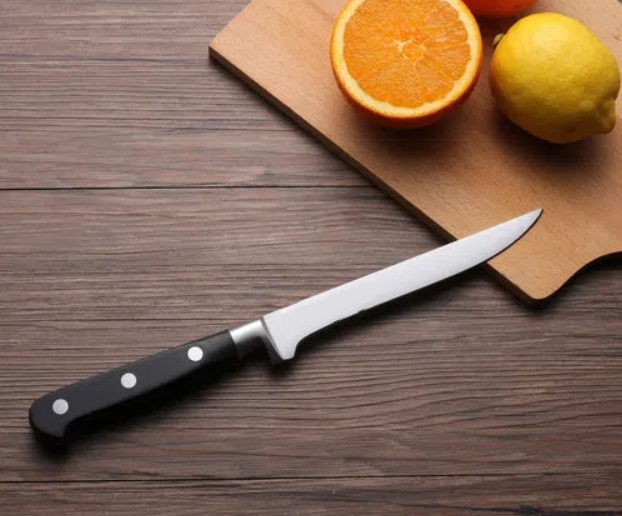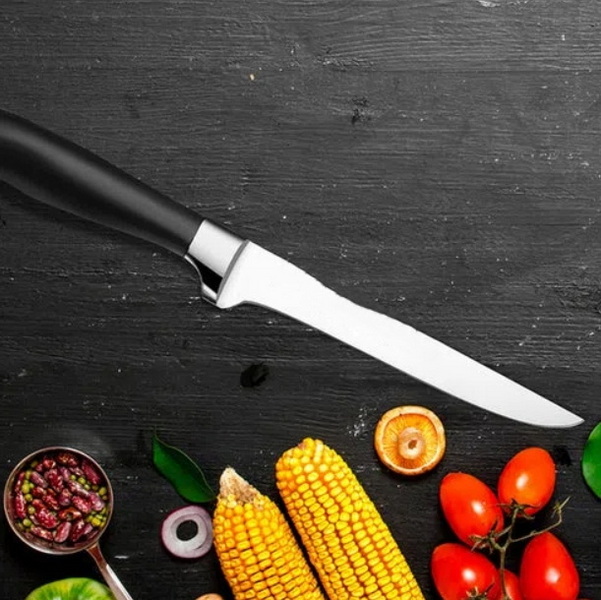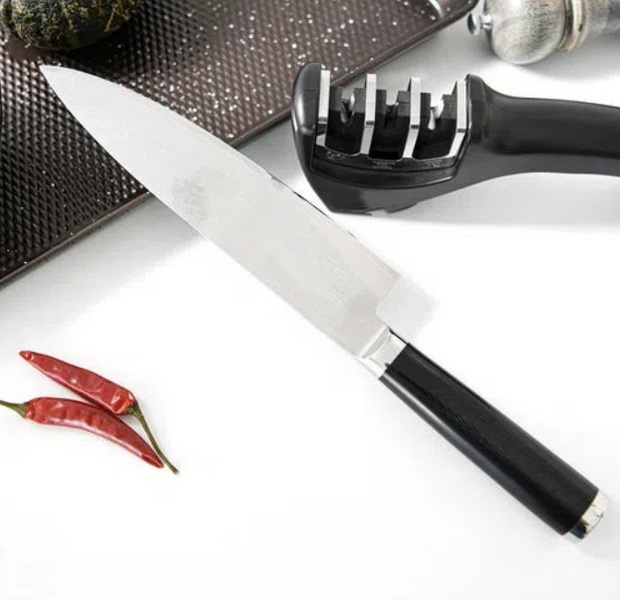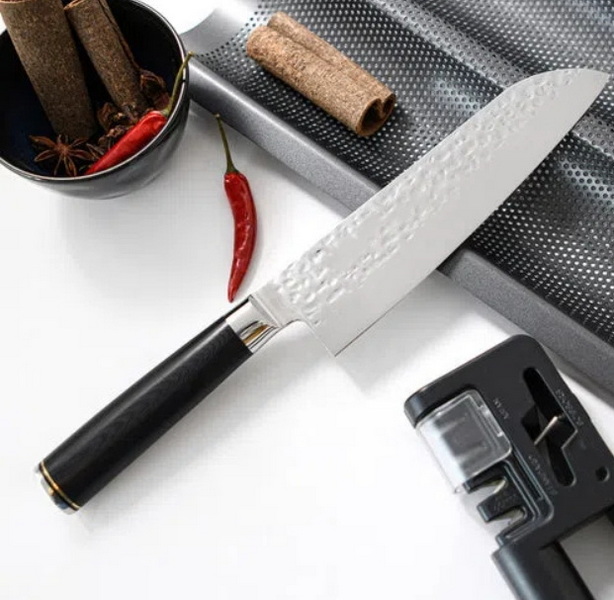

Views: 700 Author: sales@insightknife.com.cn Publish Time: 2025-01-06 Origin: Site








Content Menu
>> Importance of Proper Knife Handling
>> Keep Your Workspace Organized
>> Use the Right Cutting Board
● How to Hold a Chef Knife Safely
>> Use a Stable Cutting Surface
>> Gradually Increase Difficulty
● Frequently Asked Questions regarding Chef Knives
>> 1. What is the best way to sharpen a chef knife?
>> 2. How often should I sharpen my chef knife?
>> 3. What should I do if I accidentally cut myself while using a knife?
>> 4. Can I use a chef knife for all types of food?
>> 5. How can I prevent my knife from slipping while cutting?
When it comes to cooking, mastering the art of knife handling is essential for both safety and efficiency. Chef knives are versatile tools that can enhance your culinary skills, but improper handling can lead to accidents. This article will guide you through the best practices for holding a chef knife safely, ensuring that you can chop, slice, and dice with confidence.
A chef knife is a multipurpose kitchen tool typically ranging from 6 to 12 inches in length. It features a broad blade that tapers to a point, allowing for a rocking motion during cutting. This design makes it ideal for a variety of tasks, from chopping vegetables to slicing meat. The weight and balance of a chef knife are also crucial; a well-balanced knife feels comfortable in hand and allows for precise control. Different materials, such as stainless steel or high-carbon steel, can affect the knife's sharpness and durability, making it important to choose a knife that suits your cooking style and preferences.

Proper knife handling is crucial for several reasons. First and foremost, it minimizes the risk of injury. A well-held knife allows for better control, reducing the chances of slips that can lead to cuts. Additionally, using the correct grip can enhance your cutting technique, making your food preparation more efficient. Beyond safety, proper knife handling can also improve the quality of your cuts, leading to more uniform pieces that cook evenly. This attention to detail can elevate your dishes, making them not only taste better but also look more appealing.

It may seem counterintuitive, but a sharp knife is safer than a dull one. Dull knives require more force to cut through food, increasing the likelihood of slipping. Regularly honing and sharpening your knives will ensure they perform optimally. A sharp blade glides through ingredients with ease, allowing for cleaner cuts and reducing the risk of accidents. Investing in a good quality sharpening tool or seeking professional sharpening services can greatly enhance your kitchen experience.
A cluttered workspace can lead to accidents. Ensure that your cutting board is clean and free of any unnecessary items. This will give you ample space to maneuver your knife safely. An organized kitchen not only promotes safety but also enhances efficiency. When you know where everything is, you can work more quickly and confidently, allowing you to focus on the cooking process rather than searching for tools or ingredients.
Choose a cutting board that is stable and appropriate for the task at hand. Wooden or plastic boards are ideal for most kitchen tasks, while glass or ceramic boards can be slippery and may dull your knife. The choice of cutting board can also affect the quality of your cuts; for instance, wooden boards are gentler on knife edges and can help maintain sharpness over time. Additionally, consider having separate boards for different types of food, such as meat and vegetables, to prevent cross-contamination.

The pinch grip is widely regarded as the safest and most effective way to hold a chef knife. Here’s how to do it:
Position Your Hand: Place your dominant hand on the handle of the knife, pinching the blade between your thumb and forefinger. This grip allows for better control and stability. By pinching the blade, you can feel the knife's balance and make more precise movements.
Wrap Your Fingers: Let your remaining three fingers wrap around the handle. This grip provides a secure hold while allowing for flexibility in movement. The three fingers should be relaxed yet firm, ensuring that you can adjust your grip as needed while cutting.
Maintain a Relaxed Grip: Avoid gripping the knife too tightly. A relaxed grip will help you maintain control without causing fatigue. Tension in your hand can lead to cramping and decreased dexterity, so it’s important to stay relaxed and focused.
The handle grip is another common way to hold a chef knife, especially for beginners. Here’s how to execute it:
Grip the Handle: Wrap all five fingers around the handle of the knife. This grip is straightforward and provides a good sense of security. It is particularly useful for tasks that require less precision, such as chopping larger items.
Keep Your Knuckles in Check: Ensure that your knuckles are not protruding too far over the blade. This will help prevent accidental cuts to your fingers. Keeping your knuckles tucked in also allows for better visibility of your cutting area, making it easier to see what you are doing.
For more advanced users, the blade grip can offer additional control, especially for intricate tasks. Here’s how to use it:
Hold the Blade: With your dominant hand, grasp the blade of the knife with your thumb and forefinger, similar to the pinch grip. This grip provides a direct connection to the blade, allowing for precise movements.
Wrap Your Fingers: Use your remaining fingers to grip the handle. This grip allows for precise control, particularly when making delicate cuts. It is especially useful for tasks like mincing herbs or finely slicing vegetables, where accuracy is key.
When cutting, always keep your fingers curled under your hand that is holding the food. This technique, known as the "claw grip," protects your fingertips from the blade while providing stability to the food being cut. By tucking your fingers in, you create a natural barrier between your hand and the knife, significantly reducing the risk of injury. Practicing this grip will help you develop muscle memory, making it second nature over time.
Ensure that your cutting board is stable and does not slide around. If necessary, place a damp cloth or paper towel underneath the board to prevent movement. A stable surface allows for more controlled cuts and reduces the likelihood of accidents. Additionally, consider the height of your cutting surface; it should be at a comfortable level to avoid straining your back or arms while cutting.
Always cut away from your body and keep your other hand out of the path of the knife. This practice minimizes the risk of injury in case of a slip. By directing the blade away from yourself, you create a safer cutting environment. It’s also important to be aware of your surroundings; ensure that no one is standing too close to you while you are cutting.
Begin practicing your knife skills with soft foods like cucumbers or cooked potatoes. These items are easier to cut and will help you build confidence in your technique. Starting with softer foods allows you to focus on your grip and cutting motion without the added challenge of tougher ingredients. As you gain confidence, you can gradually introduce more challenging items into your practice routine.
As you become more comfortable, gradually move on to harder foods like carrots or raw potatoes. This progression will help you develop your skills without overwhelming you. Challenging yourself with different textures and densities will improve your overall knife skills and adaptability in the kitchen. Remember to maintain proper technique as you increase the difficulty of your tasks.
Like any skill, regular practice is key to becoming proficient in knife handling. Set aside time to practice your cutting techniques, focusing on maintaining a safe grip and proper form. Consistent practice will not only improve your skills but also build your confidence in using a knife. Consider incorporating knife skills practice into your cooking routine, allowing you to refine your technique while preparing meals.
Mastering the art of holding a chef knife safely is essential for anyone who enjoys cooking. By understanding the different grips and practicing safe cutting techniques, you can enhance your culinary skills while minimizing the risk of injury. Remember to always use a sharp knife, keep your workspace organized, and practice regularly. With time and dedication, you will become more confident in your knife handling abilities, making your cooking experience both enjoyable and safe.

The best way to sharpen a chef knife is to use a whetstone or a honing rod. A whetstone allows for precise sharpening at different angles, while a honing rod helps maintain the edge between sharpenings. Always follow the manufacturer's instructions for the specific knife you are using.
The frequency of sharpening depends on how often you use your knife. For regular home cooks, sharpening every few months is usually sufficient. However, if you use your knife daily, you may need to sharpen it every few weeks. Regular honing can help maintain the edge between sharpenings.
If you accidentally cut yourself, immediately rinse the wound under running water to clean it. Apply pressure with a clean cloth or bandage to stop the bleeding. If the cut is deep or does not stop bleeding, seek medical attention. Always keep a first aid kit handy in the kitchen for emergencies.
While a chef knife is versatile and can be used for many types of food, it is not ideal for everything. For example, it is not suitable for cutting through bones or very hard items like frozen foods. Using the right knife for specific tasks, such as a paring knife for peeling or a serrated knife for bread, will yield better results and prolong the life of your chef knife.
To prevent your knife from slipping, ensure that your cutting board is stable and not sliding around. Use a damp cloth or a non-slip mat underneath the board for added stability. Additionally, always keep your fingers in a claw grip position to maintain control over the food you are cutting, which helps prevent slips.